List of amphibians of Bulgaria
This is a complete list of the amphibians of Bulgaria. Bulgaria is inhabited by 20 amphibian species, which makes the amphibians the least diverse class of vertebrates in the country.[1] They include seven species of newts and salamanders from a single family, Salamandridae, as well as 13 frog and toad species from five families — Bombinatoridae, Bufonidae, Hylidae, Pelobatidae and Ranidae. The most recently classified species are the northern crested newt, identified in 2005,[2] and the Macedonian crested newt, identified in 2007.[3] Some of the most common species include the European green toad, yellow-bellied toad, and marsh frog.
List of species
Order Caudata
Family Salamandridae
Salamandridae, or true salamanders, are a family of terrestrial and aquatic salamanders, mostly distributed in Asia and Europe, although some species are found in North Africa and North America. Most species have slightly toxic skin secretions and many develop dorsal body and tail fins when they return to an aquatic stage. There are 109 species in 21 genera; of them, seven species in four genera are found in Bulgaria.[4]
| Species | Common name | Distribution | Statusa[›] | Image |
|---|---|---|---|---|
| Lissotriton vulgaris | smooth newt | The species is found in the whole country, up to 1500 m altitude.[5] | |
 |
| Mesotriton alpestris | Alpine newt | Most common in the Rila and western Rhodope Mountains; isolated populations in the western Balkan Mountains, central Sredna Gora and Osogovo.[1] | |
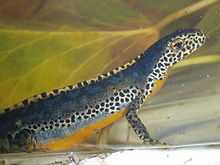 |
| Salamandra salamandra | fire salamander | Moist wooded areas in the mountains, mostly absent from the Danubian Plain and the Upper Thracian Plain.[8] | |
 |
| Triturus cristatus | northern crested newt | The species was first discovered in Bulgaria in 2005. It is found in the western Balkan Mountains near Vratsa which is its southernmost locality.[2][10][11] | |
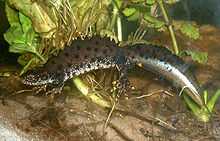 |
| Triturus dobrogicus | Danube crested newt | The species occurs in the Danube river and the lower course of its tributaries.[13] | |
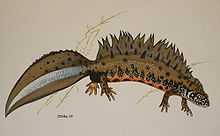 |
| Triturus karelinii | southern crested newt | The species is common in the country up to 1500 m altitude. It is absent from the Danube river and the lower course of its tributaries.[15] | |
|
| Triturus macedonicus | Macedonian crested newt | Slavyanka mountain in south-western Bulgaria.[3] | |
|
Order Anura
Family Bombinatoridae
Bombinatoridae are an Old World toad family often referred to as fire-bellied toads because of their brightly coloured ventral sides which demonstrates their high toxicity. It includes ten species in two genera, Barbourula and Bombina, both of which have flattened bodies, of which two species from genus Bombina occur in Bulgaria.[17]
| Species | Common name | Distribution | Status | Image |
|---|---|---|---|---|
| Bombina bombina | European fire-bellied toad | The species is found the lowlands of the country, up to 250 m altitude: the Danube and Upper Thracian Plains and the Black Sea Coast.[18] | |
_tight_crop.jpg) |
| Bombina variegata | yellow-bellied toad | Common species in the lower mountains, up to 2000 m altitude (in Pirin and the Balkan Mountains).[20] | |
 |
Family Bufonidae
Bufonidae are a family of toads native to every continent except Australia and Antarctica. Bufonidae include the typical toads with shortened forelimbs, hindlimbs used for walking or hopping, dry warty skin, and parotoid glands behind eyes. The family contains 590 species in 50 genera, of which 2 species from genus Bufo are found in Bulgaria.[22]
| Species | Common name | Distribution | Status | Image |
|---|---|---|---|---|
| Bufo bufo | common toad | The species is found all over the country, up to 1300 m altitude, with the exception of Pirin, where it has been recorder at 1960 m.[23] | |
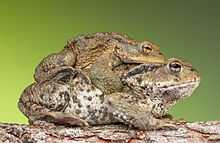 |
| Bufo viridis | European green toad | The species is found all over the country, up to 1200 m altitude. It has been recorded in Rila at an altitude of 2000 m.[25] | |
 |
Family Hylidae
Hylidae or tree frogs are the most diverse amphibian family with worldwide distribution. Most species inhabit tropical areas with warm and humid climate, especially the Neotropics. Hylids range from small to large in size and usually have distinct adhesive toe discs that contain a cartilage offsetting the terminal phalanx, which aids in climbing. There are 951 species in 51 genera. Only one genus, Hyla, is found in Europe, and one species occurs in Bulgaria.[27]
| Species | Common name | Distribution | Status | Image |
|---|---|---|---|---|
| Hyla arborea | European tree frog | The species is found all over the country, up to 1300 m altitude. It has been recorded in Rila at an altitude of 2300 m.[28] | |
 |
Family Pelobatidae
Pelobatidae, also known as spadefoot toads, are a small family of frogs with one genus and four species spread in Europe, Western Asia and North-western Africa. They have short legs, stocky bodies with vertical pupils and produce an odour similar to garlic, hence their name in Bulgarian is чесновица (chesnovica), 'garlic toad'. Two of the four species inhabit the country.[30]
| Species | Common name | Distribution | Status | Image |
|---|---|---|---|---|
| Pelobates fuscus | common spadefoot | The species is found in the areas along the Danube river, the northernmost Black Sea coast, as well as in isolated populations in Sofia Valley.[31] | |
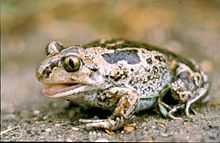 |
| Pelobates syriacus | eastern spadefoot toad | The species is found in the areas along the Danube river, the whole Black Sea coast, the Upper Thracian Plain and the southern Struma valley.[31] | |
 |
Family Ranidae
Ranidae are a widespread family also known as true frogs. They have generalized frog body plans and a generalized aquatic tadpole stage. The family includes 379 species in 14 genera, of which six species in two genera occur in Bulgaria.[34]
| Species | Common name | Distribution | Status | Image |
|---|---|---|---|---|
| Pelophylax kl. esculentus | edible frog | The species is found along the Danube river and the lower course of its tributaries, as well as along the Black Sea coast.[35] | |
 |
| Pelophylax lessonae | pool frog | Westernmost areas along the Bulgarian Danube bank.[37] | |
|
| Pelophylax ridibundus | marsh frog | The species is found all over the country, up to 1300 m altitude. It has been recorded in Belasitsa at an altitude of 2000 m.[39] | |
 |
| Rana dalmatina | agile frog | The species is found all over the country, up to 1200 m altitude, with singular records up to 2000 m.[41] | |
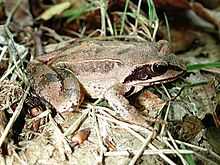 |
| Rana graeca | Greek stream frog | The species occurs in south-western Bulgaria.[43] | |
 |
| Rana temporaria | common frog | The species is found mostly in the mountains, between 1000 and 2000 m altitude: Balkan Mountains, Rila, Pirin, Vitosha, Osogovo, Rhodope Mountains.[45] | |
.jpg) |
See also
- Geography of Bulgaria
- List of birds of Bulgaria
- List of mammals of Bulgaria
- List of reptiles of Bulgaria
- List of protected areas of Bulgaria
Footnotes
Notes
^ a: Conservation status at a world level (not exclusive to Bulgaria) of the species according to the IUCN Red List: Conservation status - IUCN Red List of Threatened Species:
- EX - Extinct, EW - Extinct in the wild
- CR - Critically endangered, EN - Endangered, VU - Vulnerable
- NT - Near threatened, LC - Least concern
- DD - Data deficient, NE - Not evaluated
Citations
- ↑ 1.0 1.1 Biserkov 2007, p. 34
- ↑ 2.0 2.1 Biserkov 2007, p. 37
- ↑ 3.0 3.1 Naumov, Borislav; Tzankov, Nikolay (2008). [record of Triturus macedonicus (Karaman, 1922) (Amphibia: Salamandridae) in Bulgaria].
- ↑ "Salamandridae". AmphibiaWeb. Retrieved 18 March 2015.
- ↑ Biserkov 2007, p. 33
- ↑ Arntzen, J.W. et al. (2009). Lissotriton vulgaris. In: IUCN 2008. IUCN Red List of Threatened Species. Retrieved 13 March 2015.
- ↑ Arntzen, J.W. et al. (2009). Mesotriton alpestris. In: IUCN 2008. IUCN Red List of Threatened Species. Retrieved 13 March 2015.
- ↑ Biserkov 2007, p. 32
- ↑ Arntzen, J.W. et al. (2009). Salamandra salamandra. In: IUCN 2008. IUCN Red List of Threatened Species. Retrieved 13 March 2015.
- ↑ Tzankov, Nikolay; Stoyanov, Andrei (2008). Triturus cristatus (Laurenti, 1768): a new species for Bulgaria from its southernmost localities. ISSN 0036-3375.
- ↑ "Triturus cristatus". AmphibiaWeb. Retrieved 13 March 2015.
- ↑ Arntzen, J.W. et al. (2009). Triturus cristatus. In: IUCN 2008. IUCN Red List of Threatened Species. Retrieved 13 March 2015.
- ↑ Biserkov 2007, p. 38
- ↑ Arntzen, J.W. et al. (2009). Triturus dobrogicus. In: IUCN 2008. IUCN Red List of Threatened Species. Retrieved 13 March 2015.
- ↑ Biserkov 2007, p. 36
- ↑ Arntzen, J.W. et al. (2009). Triturus karelinii. In: IUCN 2008. IUCN Red List of Threatened Species. Retrieved 13 March 2015.
- ↑ "Bombinatoridae". AmphibiaWeb. Retrieved 18 March 2015.
- ↑ Biserkov 2007, p. 45
- ↑ Arntzen, J.W. et al. (2009). Bombina bombina. In: IUCN 2008. IUCN Red List of Threatened Species. Retrieved 13 March 2015.
- ↑ Biserkov 2007, p. 46
- ↑ Arntzen, J.W. et al. (2009). Bombina variegata. In: IUCN 2008. IUCN Red List of Threatened Species. Retrieved 13 March 2015.
- ↑ "Bufonidae". AmphibiaWeb. Retrieved 18 March 2015.
- ↑ Biserkov 2007, p. 51
- ↑ Arntzen, J.W. et al. (2009). Bufo bufo. In: IUCN 2008. IUCN Red List of Threatened Species. Retrieved 13 March 2015.
- ↑ Biserkov 2007, pp. 52–53
- ↑ Arntzen, J.W. et al. (2009). Bufo viridis. In: IUCN 2008. IUCN Red List of Threatened Species. Retrieved 13 March 2015.
- ↑ "Hylidae". AmphibiaWeb. Retrieved 18 March 2015.
- ↑ Biserkov 2007, pp. 54
- ↑ Arntzen, J.W. et al. (2009). Hyla arborea. In: IUCN 2008. IUCN Red List of Threatened Species. Retrieved 13 March 2015.
- ↑ "Pelobatidae". AmphibiaWeb. Retrieved 18 March 2015.
- ↑ 31.0 31.1 Biserkov 2007, p. 48
- ↑ Arntzen, J.W. et al. (2009). Pelobates fuscus. In: IUCN 2008. IUCN Red List of Threatened Species. Retrieved 13 March 2015.
- ↑ Arntzen, J.W. et al. (2009). Bufo viridis. In: IUCN 2008. IUCN Red List of Threatened Species. Retrieved 13 March 2015.
- ↑ "Pelobatidae". AmphibiaWeb. Retrieved 18 March 2015.
- ↑ Biserkov 2007, p. 60
- ↑ Arntzen, J.W. et al. (2009). Pelophylax kl. esculentus. In: IUCN 2008. IUCN Red List of Threatened Species. Retrieved 13 March 2015.
- ↑ Biserkov 2007, p. 62
- ↑ Arntzen, J.W. et al. (2009). Pelophylax lessonae. In: IUCN 2008. IUCN Red List of Threatened Species. Retrieved 13 March 2015.
- ↑ Biserkov 2007, p. 59
- ↑ Arntzen, J.W. et al. (2009). Pelophylax ridibundus. In: IUCN 2008. IUCN Red List of Threatened Species. Retrieved 13 March 2015.
- ↑ Biserkov 2007, p. 56
- ↑ Arntzen, J.W. et al. (2009). Rana dalmatina. In: IUCN 2008. IUCN Red List of Threatened Species. Retrieved 13 March 2015.
- ↑ Biserkov 2007, p. 57
- ↑ Arntzen, J.W. et al. (2009). Rana graeca. In: IUCN 2008. IUCN Red List of Threatened Species. Retrieved 13 March 2015.
- ↑ Biserkov 2007, p. 58
- ↑ Arntzen, J.W. et al. (2009). Rana temporaria. In: IUCN 2008. IUCN Red List of Threatened Species. Retrieved 13 March 2015.
References
Sources
- Biserkov, V. (2007). Определител на земноводните и влечугите в България (A Field Guide to Amphibians and Reptiles of Bulgaria) (in Bulgarian). София (Sofia): Зелени Балкани (Green Balkans). ISBN 978-954-9433-07-4.
- Beshkov, Vladimir; Nanev, Krastyo (2002). Земноводни и влечуги в България (Amphibians and Reptiles of Bulgaria) (in Bulgarian). София (Sofia): Пенсофт (Pensoft). ISBN 954-642-147-2.
External links
- Naumov, B.; Stanchev, M. "Amphibians and reptiles of Bulgaria and the Balkan Peninsula" (in Bulgarian). An online edition of the Bulgarian Herpetological Society. Retrieved 13 March 2015.
- Mazzei, P. "Amphibians and reptiles of Europe". Retrieved 13 March 2015.
- "AmphibiaWeb". Retrieved 13 March 2015.
- "The IUNC List of Threatened Species". Retrieved 13 March 2015.